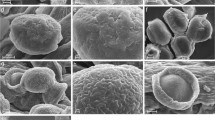Abstract
Pollen and seed morphology of five species of Ruellia L. and one species each of Phaulopsis Willd. and Dyschoriste Nees (Acanthaceae: Ruellioideae: Ruellieae) of Yemen have been examined using light and scanning electron microscopes. Pollen descriptions were provided with three shapes distinguished, spheroidal in Ruellia, prolate in Phaulopsis and subprolate to spheroidal in Dyschoriste, pseudocolpi are absent in all the triporate pollens of Ruellia species but present in the tricolporate pollens of Phaulopsis and the heterocolpate pollens of Dyschoriste the latter with 5–7 pseudocolpi. Surface ornamentation in Ruellia is reticulate and perforate in Phaulopsis and Dyschoriste. The seed morphology of all genera is discoid and the testa covered with hygroscopic hairs but in Ruellia and Phaulopsis the seeds are suborbicular and orbicular in outline, respectively, and ovate in Dyschoriste.






Similar content being viewed by others
References
Al Khulaidi AA (2013) Flora of Yemen. The Sustainable Natural Resource Management Project (SNRMP II) EPA and UNDP, Republic of Yemen
Balkwill K, Norris FG, Balkwill M (1997) Systematic Studies in the Acanthaceae; Dicliptera in Southern Africa. Kew Bull 51(1–2):1–60
Barthlott W (1981) Epidermal and seed surface characters of plants: systematic applicability and some evolutionary aspects. Nord j Bot 1(3):345–355
Borg AJ (2008) Phylogenetics and flora structure in Thunbergioideae and Avicennia (Acanthaceae). Licentiate Thesis, Stockholm University (Unpublished)
Carine MA, Scotland RW (1998) Pollen morphology of Strobilanthes Blume (Acanthaceae) from southern India and Sri Lanka. Rev Palaeobot Palynol 103:143–165
Clarke CB (1899) Acanthaceae. In: Thiselton-Dyer WT (ed.) Flora of Tropical Africa. 5: 44–49. Reeves & Sons Pty. Ltd., London
Daniel TF, Mbola BA, Almeda F (2007) Anisotes (Acanthaceae) in Madagascar. Miss Bot Gar 58(8):121–131
Elisens JW, Austen T, Tomb S, Manhattan K (1983) Seed morphology in New World Antirrhineae (Scrophulariaceae): systematic and phylogenetic implication. Pl Syst Evol 142:23–47
Ensermu K (2003) Two new species of Acanthaceae from NE tropical Africa and Arabia. Kew Bull 58:703–712
Erdtman G (1952) Pollen morphology and plant taxonomy. Angiosperms. 2nd ed. An introduction to palynology, 1: 30–33. Almqvist & Wiksells, Stockholm
Furness C (1989) The pollen morphology of Ecbolium and Megalochlamys (Acanthaceae). Kew Bull 44(4):681–693
Furness C (1990) Pollen morphology of Crossandra Salisbury and Crossandra C.B. Clarke (Acanthaceae). Grana 29:161–176
Furness C (1995) A Pollen morphological study of Dyschoriste Nees and Chaetacanthus Nees (Acanthaceae: Ruellieae). Rev Palaeobot Palynol 84(3–4):331–345
Furness C, Grant MC (1996) Pollen morphology of some Ruellia species (Acanthaceae) from Africa and Madagascar. Grana 35(4):231–239
Graham AW (1988) Delimitation and infra-generic classification of Justicia (Acanthaceae). Kew Bull 43(4):551–620
Hesse AH, Halbritter R, Zetter M et al (2009) Pollen terminology an illustrated handbook. Springer Wien, New York
Latiff A (2012) Seed morphology of Parthenocissus Planch. and Ampelopsis Michx. (Vitaceae) and its taxonomic significance. Sains Mala 41(12):1503–1508
Lester NR (1991) Enzyme etching treatment as an aid in the study of seed surface sculpture in Justicia and Ruellia. Bot J Linn Soc 105:285–288
Mabberley DJ (1989) The plant-book. Cambridge University Press, Cambridge
McDade LA, Moody ML (1999) Phylogenetic relationships among Acanthaceae: evidence from noncoding trnl-trnf chloroplast DNA sequences. Amer J Bot 86:70–80
McDade LA, Masta SE, Moody ML, Waters E (2000) Phylogenetic relationships among Acanthaceae: evidence from two genomes. Syst Bot 25:106–121
Miller AG (2004) Ethnoflora of the Soqotra Archipelago. Kew, pp 400–414
Perveen A, Qaiser M (2010) Pollen flora of Pakistan—LXVII: Acanthaceae. Pak J Bot Special Issues 42:175–191
Raj B (1973) Further contribution to the pollen morphology of the Acanthaceae. J Palynol 9:91–141
Schnepf E, Deichgraber G (1983) Structure and Formation of fibrillar mucilages in seed epidermis cells. II. Ruellia (Acanthaceae). Protoplasma 114:222–234
Schwarzbach AE, McDade LA (2002) Phylogenetic relationships of the mangrove family Avicenniaceae based on chloroplast and nuclear ribosomal DNA sequences. Syst Bot 27:84–98
Scotland RW (1992) Systematics, similarity and Acanthaceae pollen morphology. Bot J Linn Soc 109:529–541
Scotland RW, Vollesen K (2000) Classification of Acanthaceae. Kew Bull 5:513–580
Segarra JG, Mateu I (2001) Seed morphology of Linaria species from eastern Spain: identification of species and taxonomic implication. Bot J Linn Soc 135:375–389
Thulin M (2006) Flora of Somalia, 3rd edn. Royal Botanic Gardens, Kew, pp 374–453
Vollesen, K. 2008. Acanthaceae. Flora of Tropical East Africa. Part 1. Royal Botanic Gardens, Kew
Walker JW (1979) Contributions of electron microscopy to Angiosperm Phylogeny and systematic: significance of ultrastructural characters in delimiting higher taxa. Soc Integ and Comp Biol 19(2):609–619
Whiffin T, Tomb SA (1972) The systematic significance of seed morphology in the Neotropical Capsular—Fruited Melastomataceae. Amer J Bot 59(4):411–422
Wood JR (1997) A hand book of the Yemen Flora. Royal Botanic Garden, Kew
Wood JR, Hillcoat D, Brummitt RK (1983) Notes on the types of some names of Arabian Acanthaceae in the Forsskal Herbarium. Kew Bull 38:429–456
Acknowledgments
The authors wish to thank Mr. Idris Sharif, electron microscopy unit for his assistance rendered during pollen preparation for SEM analysis and scanning and Mr. Abdulwahab Ahmed for his cooperation during the field collection of the specimens in Yemen. The UKM-OUP-PLW-13-56-2011 is also acknowledged.
Author information
Authors and Affiliations
Corresponding author
Rights and permissions
About this article
Cite this article
Al-Hakimi, A.S., Latiff, A. Pollen and seed morphology of Ruellia L., Phaulopsis Willd. and Dyschoriste Nees (Acanthaceae: Ruellioideae: Ruellieae) of Yemen. Plant Syst Evol 301, 1–13 (2015). https://doi.org/10.1007/s00606-014-1035-7
Received:
Accepted:
Published:
Issue Date:
DOI: https://doi.org/10.1007/s00606-014-1035-7




